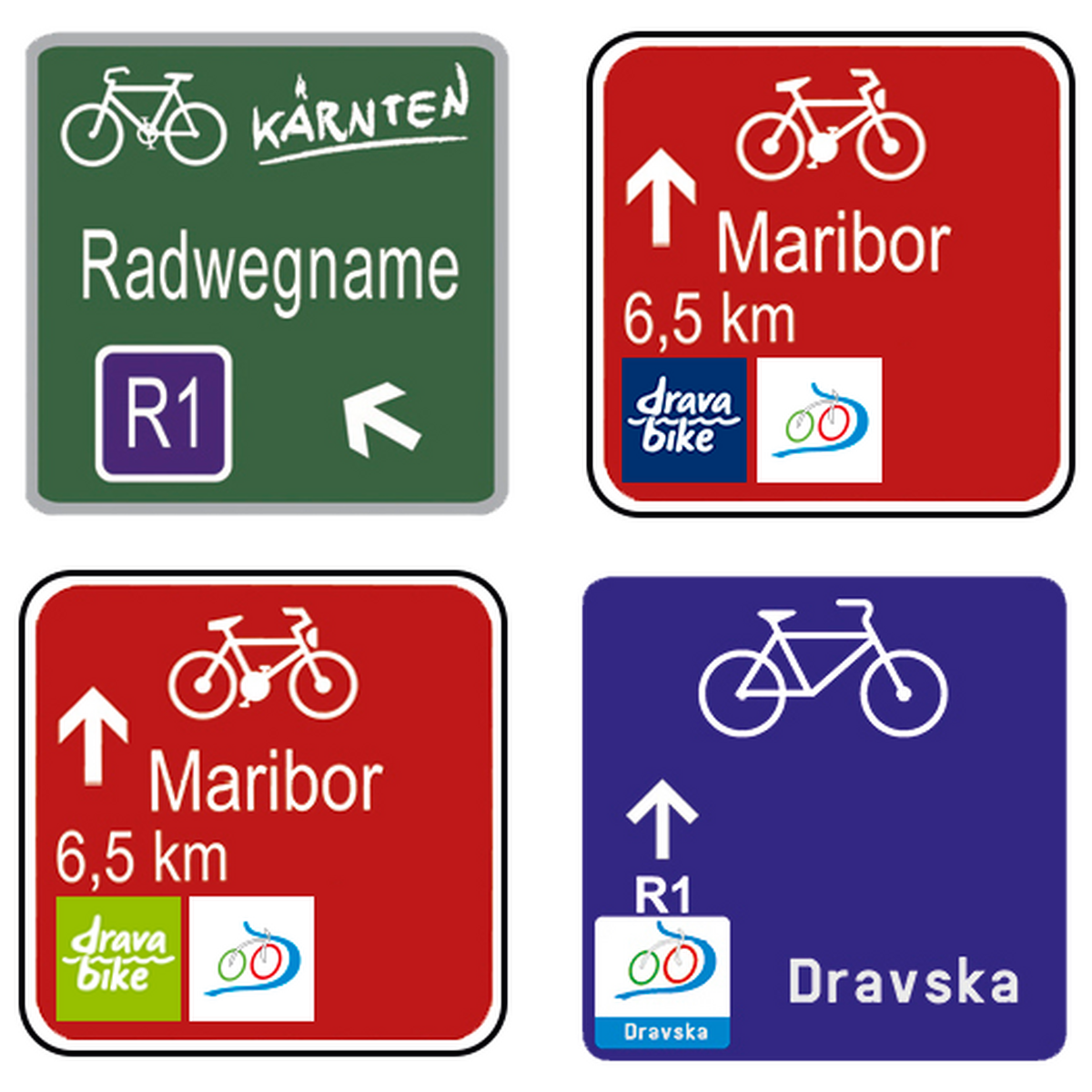Information on the
Drava Cycling Route
The river Drava and Drava Cycling Route

The cycling route along Drava runs through 4 countries (Italy, Austria, Slovenia, Croatia) and has a total length of about 510 km. The route begins right next to the source of Drava on Toblach Field (Toblach) in Italy. It then continues through Austria, Slovenia, and finally Croatia (where the route is not yet fully arranged and marked).
The first 70 km of the cycling route from the source of Drava are very interesting, since we mostly ride downslope. A large section of the cycling route runs through Carinthia and crosses the border to Slovenia at Vič, continuing through Slovenia from Dravograd past Radlje ob Dravi, Maribor and Ptuj, all the way to Ormož and Središče ob Dravi, where it crosses into Croatia after 145 km. The river and the cycling route continue their path towards Varaždin, where the river Mura (also famous for its cycling route – Mura Cycling Route), after 63 km, at Legrad, converges with the river Drava, which then flows into the Danube near Osijek.
Drava Cycling Route in Austria
Drauradweg or Drava Cycling Route in Carinthia is a very popular distance cycling route.Dravska kolesarska pot v AvstrijiADFC (German Cyclist’s Association), the most important international organisation for classification of cycling routes, marked the Drava Cycling Route in Austria with five stars, the highest possible grade for an individual route in Europe, making this route one of only four cycling routes in Europe with the highest grade.
Drava Cycling Route in Slovenia and Croatia
The Slovenian section of the Drava Cycling Route predominantly runs along less travelled local roads and to a lesser extent along arranged cycling paths and tracks. Due to various types of road surface and a more demanding climb between Podvelka and Lovrenc na Pohorju, the Slovenian section of the route is more suitable for better prepared cyclists. Trekking or mountain bikes are recommended. The climb to Lovrenc na Pohorju can be avoided by using a train connection between Podvelka and Fala.
The route starts at the border crossing Vič. We continue towards Dravograd, and then on the other side of the river Drava through Bukovje, Trbonje, Dravče, Vuzenica, and Vuhred until we reach Podvelke. Here, the route turns right, where we face the only difficult climb of the route, about 6 km to Janževski vrh, Lehen, and Lovrec na Pohorju. From Lovrenc, we continue our route through Puščava and Činžat to the village Fala, where we once again cycle right along Drava, crossing the hydroelectric power plant Fala (the oldest hydroelectric power plant on the river Drava), and then continue along the Apple Trail to Ruše. Through Bezena, Bistrica ob Dravi, Laznica, and Limbuš, past Maribor Island, a unique river island in Slovenia, we soon reach the second largest Slovenian city – Maribor.
From Maribor to Ptuj, we have a choice of two cycling routes. A more levelled route with less traffic is the one through Miklavž na Dravskem polju, Starše, and Hajdina. The alternative on the left bank of the Drava River runs over a few short and easy climbs and drops through Malečnik and Trčovo to Zgornji and Spodnji Duplek. We first cycle through Vurberk and Krčevina, and soon reach Ptuj, the oldest Slovenian city. The route then continues along Lake Ptuj, through Zabovce, Nova vas pri Markovcih and Stojnce, to Muretinci and Ormož. From Ormož, the route takes us past fields, through villages to Središče ob Dravi, where we cross the border to Croatia. The cycling route then once again comes near to the preserved section of the river Drava. We soon reach Varaždin, a city with an excellently preserved city centre.
The last section of the route runs partly along Lake Varaždin, through attractive villages to Lake Dubrava, and past Prelog towards Donja Dubrava, where it once again meets the river Drava. Here, we cross the river and make our way towards Legrad, where we can see the confluence of Mura and Drava.
| Dravograd–Radlje ob Dravi/Vuhred: | 626 m |
| Vuhred/Radlje ob Dravi–Maribor: | 963 m |
| Maribor–Ptuj via Duplek: | 228 m |
| Maribor–Ptuj via Starše: | 45 m |
| Ptuj–Ormož: | 93 m |
| Ormož–Varaždin: | 91 m |
| Varaždin–Legrad: | 38 m |
| Razmerje skupaj: | 28,6 % makadama, 71,4 % asfaltirano |
| Dravograd–Radlje ob Dravi/Vuhred: | 10 % makadama, 90 % asfaltirano |
| Vuhred/Radlje ob Dravi–Maribor: | 20 % makadama, 80 % asfaltirano |
| Maribor–Ptuj via Duplek: | 0 % makadama, 100 % asfaltirano |
| Maribor–Ptuj via Starše: | 45 % makadama, 55 % asfaltirano |
| Ptuj–Ormož: | 26 % makadama, 74 % asfaltirano |
| Ormož–Varaždin: | 45 % makadama, 55 % asfaltirano |
| Varaždin–Legrad: | 9 % makadama, 91 % asfaltirano |
| Skupaj: | 208 km |
| Dravograd–Radlje ob Dravi/Vuhred: | 26 km |
| Vuhred/Radlje ob Dravi–Maribor: | 42 km |
| Maribor–Ptuj via Duplek: | 30 km |
| Maribor–Ptuj via Starše: | 30 km |
| Ptuj–Ormož: | 28 km |
| Ormož–Varaždin: | 30 km |
| Varaždin–Legrad: | 52 km |
Bicycle route marking
The Drava Cycling Route is marked all the way from the source of Drava to the confluence of Mura and Drava. Markings are green in Austria, red in Slovenia, and blue in Croatia. All signboards use the common logo of the Drava Cycling Route, with an additional marking R1 in Austria and Croatia. In Austria, the logo is only included in larger signs.


 Warnings
Warnings
 Construction
Construction
 Weather
Weather
 Contact
Contact
 Search
Search

